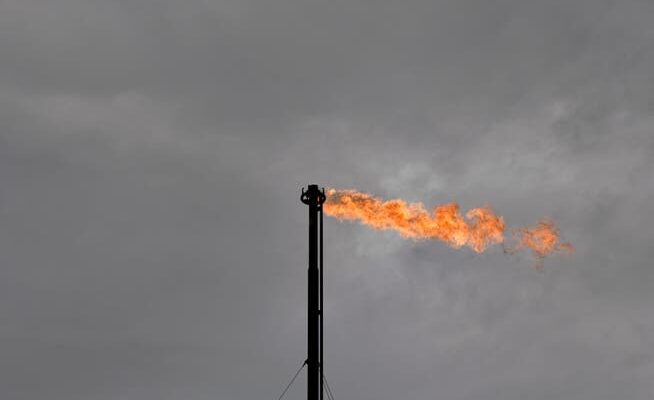Exxon’s climate calculations from 1977 to 2003 were analyzed in detail for the first time. They show a high level of agreement with the forecasts of other scientists.
Natural gas is flared at an Exxon production facility in New Mexico.
The American oil company ExxonMobil has for many years downplayed the threat of climate change. That is well documented. Whole books have been written on the subject.
Now three scientists have examined numerous documents in detail. They can prove that Exxon knew very early on and fairly precisely what problematic effects greenhouse gases have on the climate – also quantitatively. Because the company had its own scientists calculate how the gases affect the climate, and these predictions were surprisingly accurate.
That’s the nail in the coffin for ExxonMobil’s claims that it was falsely accused of climate crimes, says Harvard University’s Geoffrey Supran. Although the company had reliable knowledge about climate change, it continued to use its tactics of avoidance. Together with Naomi Oreskes, who also works at Harvard, and Stefan Rahmstorf from the Potsdam Institute for Climate Impact Research, Supran now has the results in the science magazine «Science» made public.
ExxonMobil has faced numerous charges
The company was originally called Exxon until it merged with Mobil Oil in 1999. Today, ExxonMobil is one of the largest companies in the world and one of the largest commercial greenhouse gas producers.
Dozens of lawsuits have been filed against ExxonMobil for public communications about climate change. Cities, counties and states across the US are accusing the company of misleading shareholders, engaging in deceptive marketing and causing climate damage. The “Science” article could now give these procedures even more emphasis.
The research trio examined twelve company documents with sixteen climate forecasts from the years 1977 to 2003. Some of these were internal communications, some were specialist articles that were published in scientific journals. Although these documents were known beforehand, it is only now that the forecasts have been analyzed in detail.
The temperature forecasts were very good for their time
Exxon scientists played a key role in twelve predictions. The analysis showed that between 63 and 83 percent of these forecasts corresponded well with the temperatures measured later. Averaged over all Exxon predictions, the earth’s atmosphere should warm up by around 0.2 degrees Celsius per decade. That’s how it happened. And not only that: Exxon’s climate forecasts were of a similar quality to other calculations that were made by scientists at specialist institutes in those years.
In addition, the company’s scientists predicted that man-made climate change would be detectable for the first time between 1995 and 2005. This prognosis also came true: in 1995, the UN Climate Council announced that human influence on the climate could now be proven because it differs from natural fluctuations.
“The experts at Exxon had a good understanding of the science – but that didn’t surprise me,” says climate researcher Reto Knutti from ETH Zurich, who was not involved in the study. There was even a scientist at Exxon who worked on the UN Climate Change Reports. However, the accuracy of the climate forecasts was partly due to luck: various incorrect assumptions in the calculations offset each other.
A new ice age was not imminent
The oil company was also aware that a theory circulating in the 1970s that a new ice age was imminent was not true. Glacials occur approximately every 100,000 years, and without human influence, the current interglacial period would indeed eventually come to an end.
However, based on internal calculations, Exxon realized early on that there was no threat of a new ice age on Earth, but rather that a “super interglacial” was to be expected due to emissions of the greenhouse gas carbon dioxide – i.e. a warm period with long-lasting and unusually high temperatures .
It remains to be seen whether the new study will be used for the court proceedings. That’s speculation, says Geoffrey Supran, but he assumes so. Previous studies on Exxon’s disinformation by him and other scientists were also cited in the proceedings.
“ExxonMobil is a prime example”
The fact that ExxonMobil questions climate science in its public corporate communications, even though it had internally robust scientific knowledge about the climate crisis, is a recurring example of this industry and of ExxonMobil in particular, judges Nadine Strauss from the Institute for Communication Science and Media Research at the University of Zurich. In the area of sustainability communication, the ExxonMobil case is a prime example of the fact that the world’s largest emitters are evading their responsibility in the climate crisis – and have been for years.
